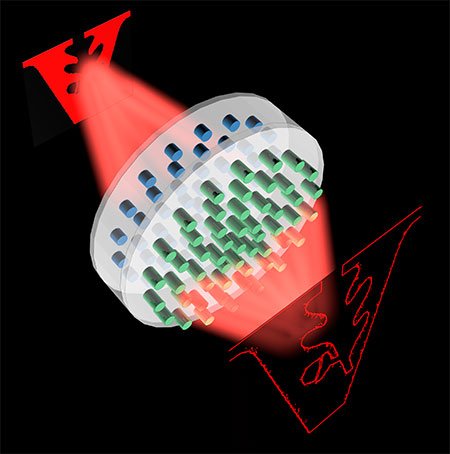A research team of Vanderbilt engineers that includes a scientist at Oak Ridge National Laboratory has demonstrated a new ultrathin filter, based on metamaterials, that allows for analog optical image processing. Their work, Flat Optics for Image Differentiation, appears today in the scientific journal, Nature Photonics.
While digital image processing has become the prevailing technique in a variety of science and engineering disciplines, it requires advanced computers, space to accommodate the computer, and substantial power.

“Most image processing is performed digitally, but optical analog processing has the advantages of being low power and high speed,” said Jason Valentine, associate professor of mechanical engineering and deputy director of the Vanderbilt Institute of Nanoscale Science and Engineering. While optical image processing has been performed in the past it generally requires multiple optical lenses resulting in a large system size.
The metamaterial filter, the first of its kind, differentiates the incoming light directly, allowing one to directly image the edges, or boundaries, of the object.
“Edge filtering is a common pre-processing step in object recognition, for instance, detecting the edge of a lane for autonomous vehicles. It can also be used for detecting margins of tumors in medical imagining or in classifying cell size and type in the case of cell sorting for cancer detection,” Valentine said.
The metamaterial filter is based on a two-dimensional photonic crystal made from silicon that allows for direct imaging of the edges of an object in all directions. The ‘nanophotonic differentiator’ can be integrated into an optical microscope or onto a camera sensor, easily adapting an existing image processing system.

“One of the primary benefits of our approach is the ability to integrate the metamaterial with traditional optical systems. As an example, we built an edge detection microscope by simply placing the metamaterial filter within a commercial optical microscope,” said You Zhou, a Ph.D. student in the Interdisciplinary Materials Science Program and one of the four authors. Testing included imaging the cells of onion epidermis, pumpkin stem and pig motor nerve.
The filter—thinner than a human hair—also was integrated with a metamaterial-based lens, resulting in a completely flat, and ultrathin optic that can perform edge imaging. This further reduces the size of traditional optical systems used for this purpose.
“The key feature is the ability to perform image processing at the speed of light while requiring no input power and doing so in an extremely thin form factor,” Valentine said. “This opens new doors for real-time and high speed optical analog image processing in applications such as machine vision and biological imaging.”
Fabrication of the materials was performed in the Vanderbilt Institute of Nanoscale Science and Engineering and at the Center for Nanophase Materials Sciences, a Science User Facility at the Oak Ridge National Laboratory. Ivan Kravchenko, a physicist at ORNL, and Hanyu Zheng, a Ph.D. student in the Electrical Engineering Department at Vanderbilt, also are team members.
The research is supported by awards from the Office of Naval Research (N00014-18-1-2563) and DARPA (HR001118C0015).
Contact: Brenda Ellis, 615 343-6314
brenda.ellis@vanderbilt.edu